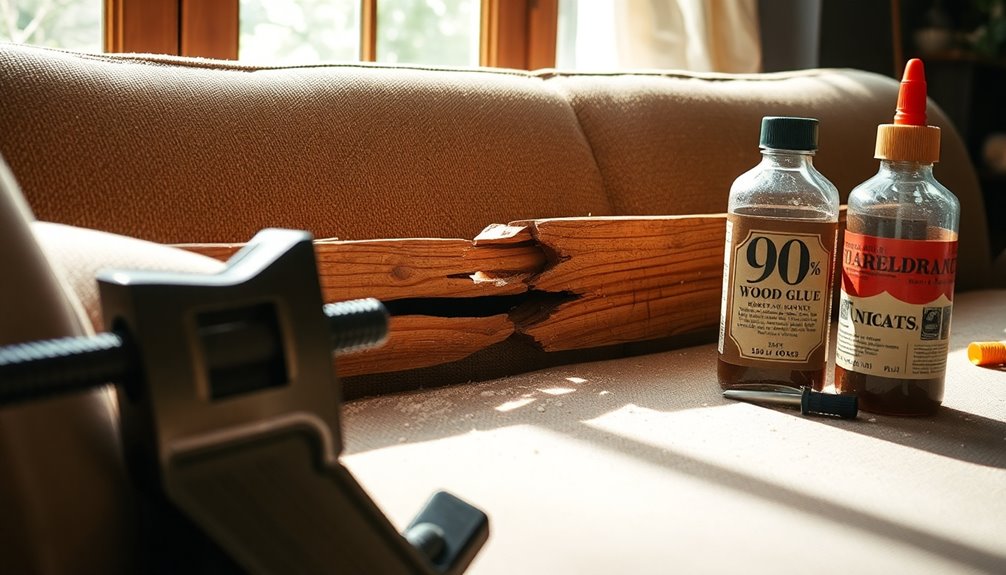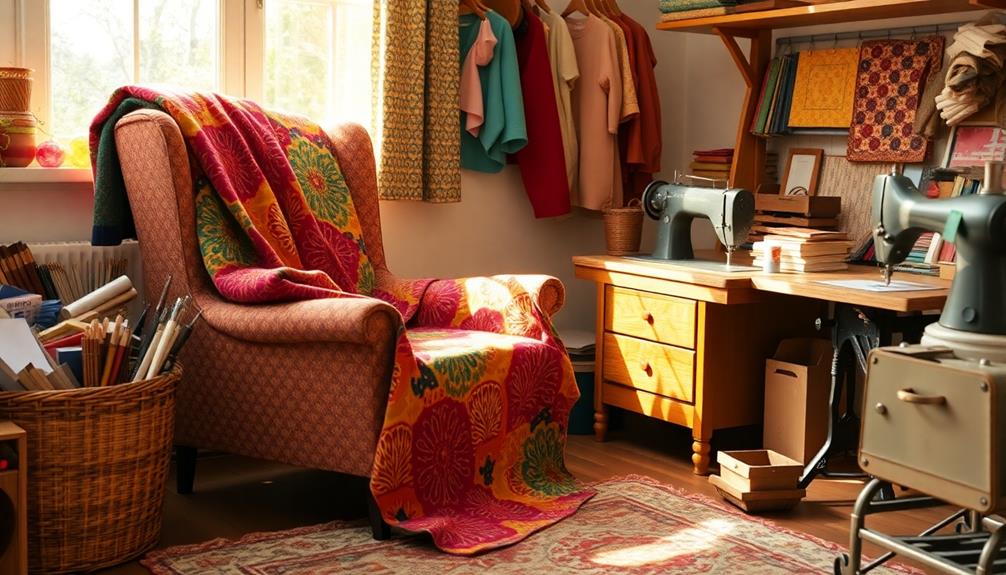To fix a broken sofa frame, start by inspecting it for any sagging or broken areas. Reinforce weak joints with metal brackets and wood glue. Use screws or finish nails for extra durability. If needed, add cross beams or slats to help distribute weight evenly. Tighten any loose screws or bolts and keep an eye on potential wear over time. Regularly dust and clean the frame to maintain its integrity. With these handy tips, you can restore your sofa's strength and comfort. Stick around, and you'll discover more ways to enhance its longevity and beauty.
Key Takeaways
- Inspect the frame thoroughly for sagging or broken areas and identify weak joints needing reinforcement.
- Use metal brackets at connection points and apply wood glue to strengthen joints effectively.
- Secure joints with finish nails or screws to enhance durability and prevent future damage.
- Install cross beams or slats to distribute weight evenly and support the sofa's structure.
- Regularly check the frame and support structure to catch potential issues early and prolong the sofa's lifespan.
Introduction
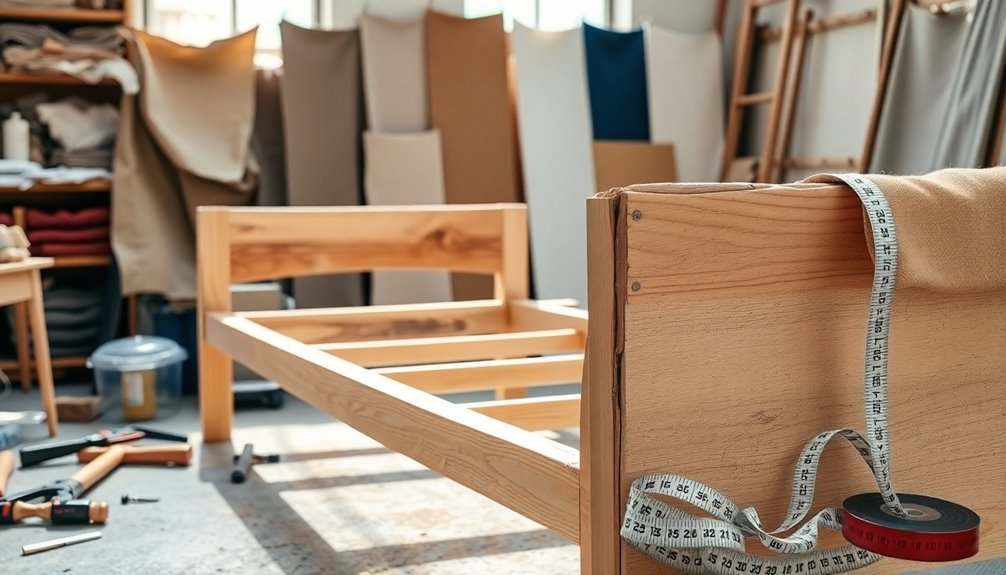
Caring for your sofa goes beyond just fixing the frame; it involves regular maintenance to keep it looking great. You'll want to incorporate routine dusting and vacuuming, use fabric-specific cleaning techniques, and know how to tackle those pesky red wine spills. By staying on top of these tasks, you can prolong the life of your sofa and maintain its comfort and style.
Routine Dusting and Vacuuming
Regularly dusting and vacuuming your sofa can significantly extend its lifespan and keep it looking its best. Incorporating routine dusting and vacuuming into your cleaning schedule not only enhances your sofa's aesthetic but also prevents the buildup of debris and allergens that can lead to wear and tear on both the upholstery and frame over time.
Use a vacuum cleaner with an upholstery attachment to effectively reach crevices and eliminate dust from the fabric. Make sure to focus on seams and beneath cushions, where dirt tends to accumulate. For wooden frames, a soft, dry cloth will do wonders for wiping away dust, while a slightly damp cloth can help tackle any sticky residues without damaging the finish.
To maintain your sofa's appearance and longevity, aim to vacuum at least once a week, especially if you have pets or high foot traffic in your home. Regular cleaning also allows you to catch potential issues early, like loose components or fabric wear. By committing to routine dusting and vacuuming, you'll keep your sofa in top shape for years to come.
Fabric-Specific Cleaning Techniques
Understanding fabric-specific cleaning techniques is essential for maintaining your sofa's appearance and durability. Each type of fabric requires a different approach to ensure it looks its best. For instance, gently vacuum velvet to avoid crushing the fibers, while polyester can usually be cleaned with a mild soap solution. When it comes to leather sofas, use a damp cloth followed by a dedicated leather conditioner to keep the material supple and prevent cracking.
Microfiber needs a different touch; apply rubbing alcohol with a clean cloth to lift stains effectively without leaving moisture that could damage the fabric. Natural fibers like cotton should be spot-cleaned using a mixture of water and white vinegar, which helps remove stains without risking discoloration.
Always check the manufacturer's care tag for specific cleaning instructions and recommended products. Following these fabric-specific cleaning techniques ensures that you're not only removing stains but also prolonging the life of your sofa. With the right care, your sofa will continue to enhance your living space beautifully.
Tackling Red Wine Spills
Even with the best cleaning techniques, accidents can happen, and red wine spills can pose a serious threat to your sofa's fabric. If you find yourself in this situation, you're going to start by acting quickly. Blot the spill gently with a clean, dry cloth to absorb as much wine as possible. Remember, don't rub; that'll only spread the stain further.
Next, you'll want to treat the stain. Mix equal parts of white wine and club soda, or opt for a solution of dish soap and hydrogen peroxide. Apply this mixture to the stained area using a cloth, allowing it to sit for a few minutes before rinsing with cold water. After rinsing, blot the area dry to ensure you remove any leftover cleaning solution.
If the stain persists, consider using a commercial upholstery cleaner specifically designed for red wine removal. Always follow the manufacturer's instructions for the best results. By taking swift action and using the right methods, you can significantly reduce the chances of permanent damage to your beloved sofa.
Sunlight Exposure Management
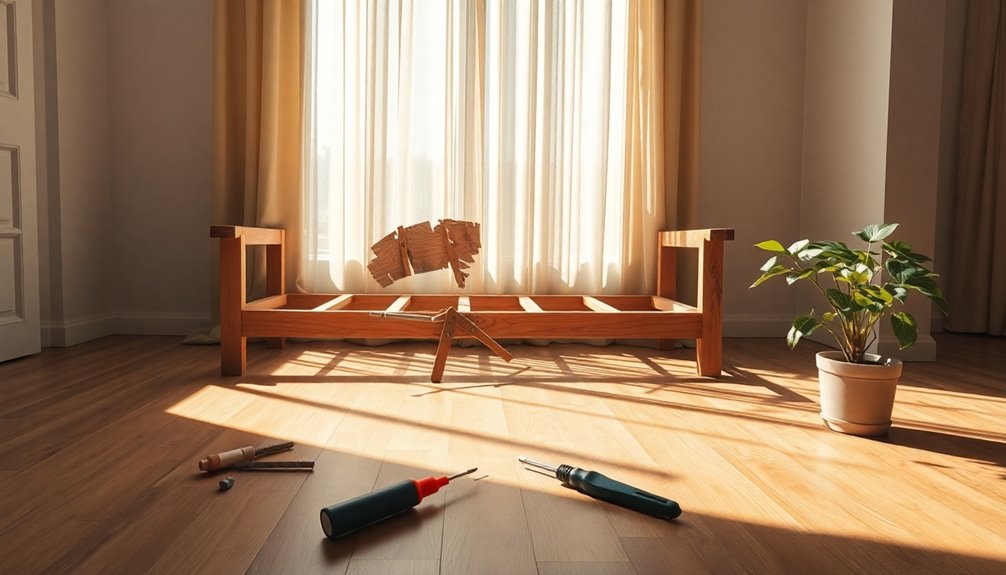
Managing sunlight exposure is crucial for protecting your sofa frame from damage. You might want to consider scratch-resistant finishes and stylish slipcovers that not only enhance appearance but also provide an extra layer of defense. Plus, using coasters on surfaces can help prevent additional wear and tear from everyday use.
Scratch-Resistant Furniture Finishes
When you invest in furniture, protecting it from scratches and sunlight damage is essential for maintaining its beauty and longevity. One effective way to achieve this is by using scratch-resistant furniture finishes. Options like polyurethane or acrylic create a durable barrier against everyday wear and tear, helping to fend off scratches from pets and heavy use.
When choosing a scratch-resistant finish, look for products with a hardness rating of at least 2H on the pencil hardness scale. This ensures optimal durability against scratches. Additionally, consider finishes that offer UV-resistant coatings. These will help mitigate the effects of sunlight exposure, reducing fading and discoloration over time.
Regular maintenance is crucial for prolonging the life of your scratch-resistant finishes. Clean your furniture with non-abrasive materials and avoid harsh chemicals to maintain their protective qualities. Every few years, applying additional layers of scratch-resistant finish can rejuvenate and reinforce the surface. This ensures continued protection against scratches and sunlight damage, keeping your furniture looking its best. By investing in scratch-resistant furniture finishes and proper care, you can enjoy your beautiful pieces for years to come.
Protect With Stylish Slipcovers
To keep your sofa looking fresh and vibrant, stylish slipcovers offer an effective solution against sunlight exposure. These slipcovers act as a protective barrier, preventing the fabric from fading and deteriorating over time. High-quality slipcovers, often crafted from UV-resistant materials, can significantly extend the lifespan of your upholstery, keeping it looking great for years.
One of the best features of slipcovers is their practicality. They're easy to remove and wash, allowing you to maintain your sofa's appearance while safeguarding it against sun damage. When selecting slipcovers, consider opting for darker colors or patterns. This choice can help minimize the visual effects of any fading that might occur, ensuring your furniture remains aesthetically appealing.
To maximize protection, regularly replace or rotate your slipcovers. This practice ensures that different areas of your sofa are shielded effectively over time, providing comprehensive coverage against sunlight exposure. By incorporating stylish slipcovers into your home, you can enjoy both protection and a fresh look, keeping your sofa in top shape while adding a touch of style to your living space.
Using Coasters on Surfaces
Using coasters on surfaces is a simple yet effective way to protect your furniture from everyday wear and tear. By providing a barrier between your drinkware and the surface, coasters help prevent scratches, water rings, and heat marks from damaging your furniture. Opt for coasters made from materials like cork or silicone; these can absorb moisture and guard against temperature fluctuations, which is especially crucial for wooden pieces that can warp or crack over time.
To maximize their effectiveness, choose coasters that are at least 4 inches in diameter. This size accommodates most drinkware and minimizes the chance of spills reaching your furniture. Regularly using coasters not only protects your surfaces but also extends the lifespan of your furniture, reducing the direct contact that leads to wear and tear.
Don't forget about aesthetics—select coasters that complement your decor. This way, you maintain your style while ensuring functional protection against everyday use. By incorporating coasters into your routine, you'll keep your furniture looking great and in good condition for years to come.
Frame Reinforcement Techniques
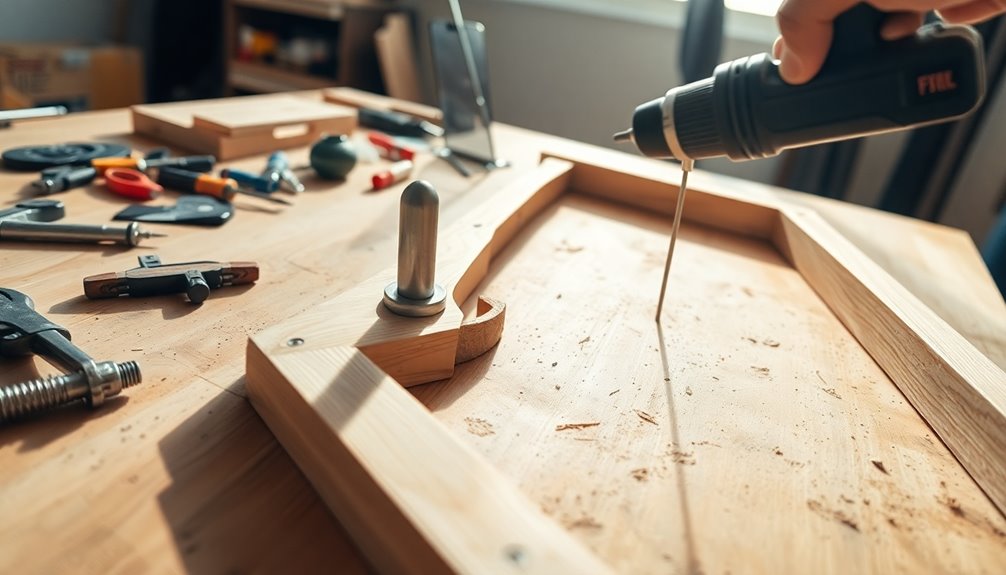
When it comes to reinforcing your sofa frame, you'll want to focus on techniques that address joint weaknesses first. By using metal brackets or wood glue with finish nails, you can significantly boost the stability of those vulnerable areas. Let's explore how these methods can enhance not just the frame, but also the overall comfort and longevity of your sofa.
Joint Weakness Repair Techniques
Reinforcing weak joints in your sofa frame is essential for maintaining its stability and durability. One effective joint weakness repair technique is to use metal corner brackets. These brackets provide additional support at critical connection points, ensuring your frame can withstand regular use. Start by applying wood glue to the joints, which enhances the strength of the repair. After applying the glue, secure the joints with finish nails or screws for added durability.
While the adhesive dries, use clamps to hold the joints tightly together. This step is crucial, as it prevents any misalignment and ensures a solid bond. If you notice any damaged wooden blocks or braces, replace them with thicker, sturdier wood to improve the overall structural integrity of your sofa frame.
Regularly inspect and maintain the joints to catch any signs of weakness early. By addressing these issues promptly, you can prolong the lifespan of your furniture and avoid more extensive repairs down the line. With these joint weakness repair techniques, your sofa can regain its strength and functionality, making it a reliable piece in your home.
Fabric and Leather Rejuvenation
A well-maintained sofa not only looks great but also provides the support needed for daily use. When you’re reinforcing a broken sofa frame, it’s essential to tackle the fabric and leather rejuvenation carefully. Start by disassembling the affected area without damaging the upholstery. Remove any staples or fabric gently, so you can reattach it later. Once you’ve accessed the broken frame, assess the damage and consider using wood glue or brackets to reinforce the structure. After securing the frame, focus on restoring the upholstery to its former glory, especially when repairing bonded leather sofa peeling. Carefully patch any worn areas with suitable materials, ensuring a seamless blend with the existing fabric for a polished finish.
Next, measure and cut thicker, sturdier wood to replace any broken pieces for optimal support. Apply wood glue to all joints before securing them with screws or finish nails. This step enhances the bond and reinforces the frame against future stress. For extra stability, consider adding metal corner brackets or angle braces at critical joints, especially around the back of the couch, where tension is often highest.
After reinforcing the frame, it's time to reattach the fabric. Use a staple gun to ensure a tight fit that restores the sofa's aesthetic while securing the newly reinforced frame. With these steps, you'll not only fix the structural issues but also rejuvenate the overall look of your sofa, making it a comfortable and visually appealing piece in your living space.
Cushion Support Enhancement
Cushion support is crucial for a comfortable sofa experience, so addressing frame reinforcement techniques can make a significant difference. Start by inspecting your sofa frame for any sagging or broken areas, especially around the support structures like corner braces and wooden blocks. These are often the main culprits of instability.
To reinforce the frame, consider adding thicker pieces of wood or metal brackets to the corners and joints. These materials can greatly enhance durability and support weight. Once you've selected your materials, use construction adhesive in conjunction with screws or finish nails to secure these new support pieces, creating a strong bond that withstands regular use.
For even more support, install additional cross beams or slats beneath the cushions. This helps distribute weight more evenly and prevents sagging over time. Remember to regularly check the frame and support structure for wear and tear. Proactive reinforcement can extend your sofa's lifespan and help you avoid more extensive repairs down the line. By taking these steps, you'll ensure your sofa remains comfortable and sturdy for years to come.
Personalized Cushion Sizing
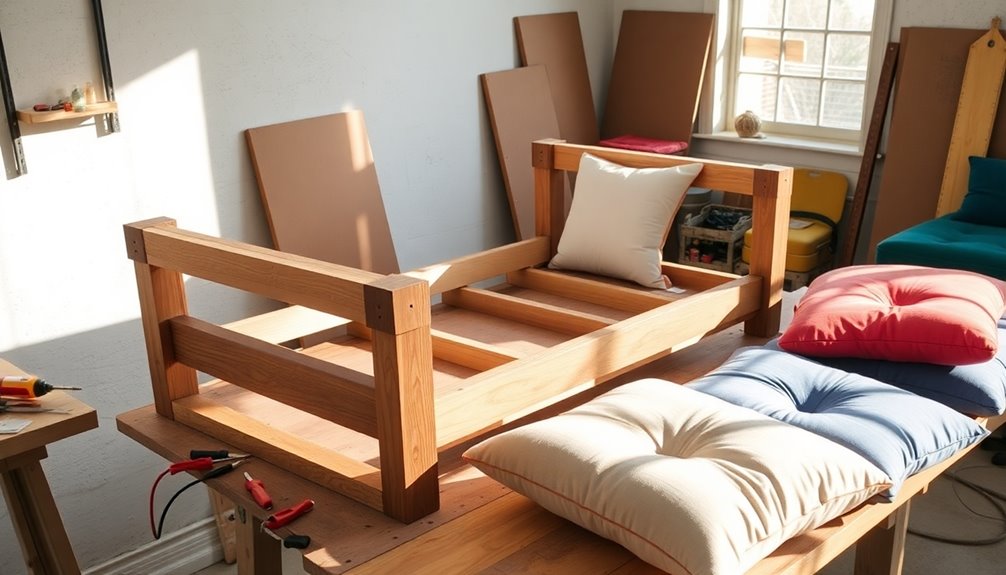
Getting the right fit for your sofa cushions can make a world of difference in both comfort and style. To achieve personalized cushion sizing, start by measuring the width, depth, and height of your sofa's seat area. This ensures a snug fit that matches the frame's dimensions. When you're choosing cushion thickness, consider your desired comfort level; standard thicknesses typically range from 4 to 6 inches for optimal support.
For durability, you're going to add high-density foam for your cushions. This material maintains its shape over time, making it ideal for personalized sizing. Additionally, custom covers can be made to fit your cushions perfectly, allowing you to choose fabrics and designs that coordinate with your sofa.
Keep in mind that over time, cushions may sag or compress, which might require you to adjust your dimensions slightly larger to maintain comfort. By taking these factors into account, you ensure that your personalized cushions not only look great but also provide the support you need. With the right measurements and materials, you'll enjoy a comfortable seating experience that breathes new life into your sofa.
Seasonal Maintenance Tips
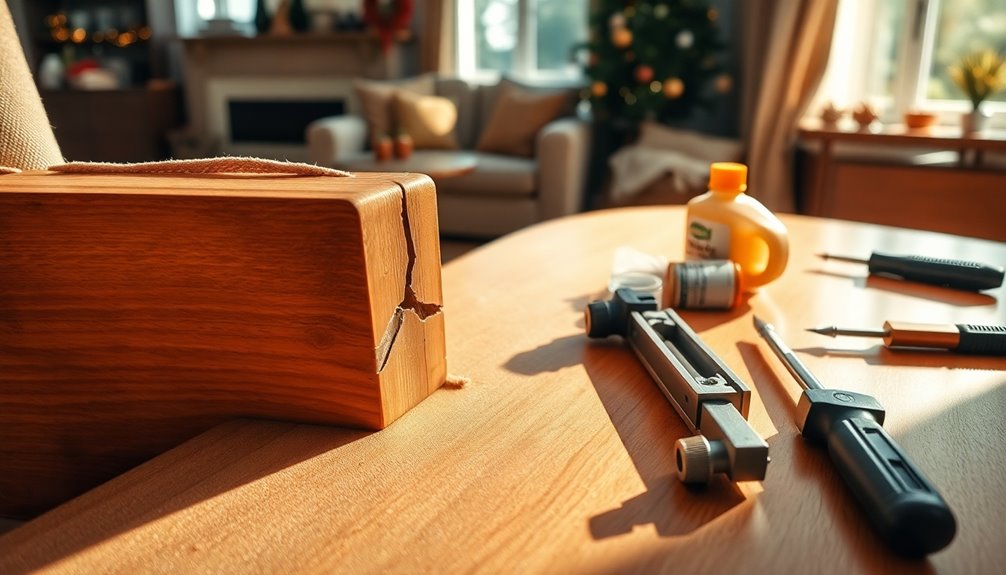
To keep your sofa in top shape year-round, seasonal maintenance is essential. Start by regularly inspecting the sofa frame for signs of wear or damage, especially at joints and support structures. Catching issues early can save you from bigger problems down the line. Rotate and fluff cushions each season to maintain their shape and prevent sagging, ensuring even wear across all seating areas.
Cleaning the sofa fabric according to the manufacturer's instructions is crucial, as accumulated dirt can weaken the frame and affect durability. Don't forget to check and tighten any loose screws or bolts on the frame every few months. This simple task helps maintain structural integrity and prevents further damage.
Additionally, consider applying wood treatment products to exposed frame areas. This protects against moisture and environmental changes that can lead to deterioration. By following these seasonal maintenance tips, you'll keep your sofa looking great and functioning well for years to come. Remember, a little effort now can prevent costly repairs later, ensuring your investment remains comfortable and stylish.
Conclusion
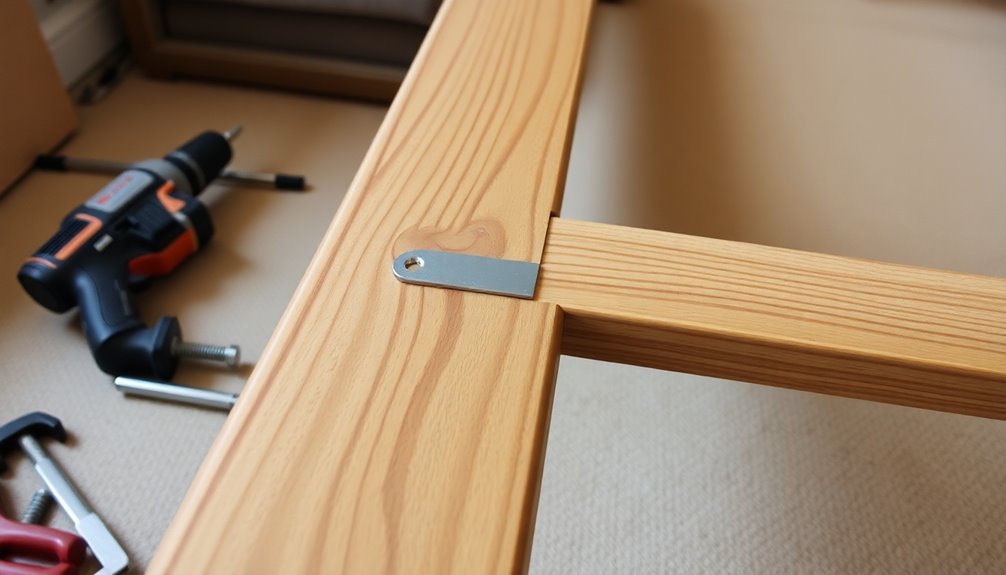
In summary, tackling a broken sofa frame is a manageable DIY project that can breathe new life into your furniture. By assessing the damage, you can identify broken or loose components that might need disassembly for a thorough evaluation. Using sturdy replacement materials, like thicker scrap wood or metal brackets, will reinforce the frame and ensure long-term durability.
Employing woodworking tools like clamps, a staple gun, and wood glue will help you secure and stabilize the frame while reassembling it. Remember to reattach any loose springs carefully, ensuring proper alignment to restore the sofa's functionality and enhance its overall strength. This step is crucial for getting everything back into place.
Completing this DIY repair not only saves you money compared to buying a new sofa but also promotes sustainability by reusing existing furniture. With a little effort and the right tools, you can successfully repair your sofa frame and enjoy your revitalized seating for years to come. So grab your tools, roll up your sleeves, and don't hesitate to embrace this rewarding project! You'll feel accomplished knowing you fixed it yourself.
Frequently Asked Questions
Can You Fix a Broken Sofa Frame?
Yes, you can fix a broken sofa frame. Start by identifying the damaged parts, like broken wood pieces or loose springs. Disassemble the sofa carefully and remove any fabric or staples. Use wood glue, screws, or metal brackets to reinforce the structure. With basic tools like clamps and a staple gun, you'll find the repair manageable. Not only will you save money, but you'll also extend the life of your sofa significantly.
How Much to Fix a Broken Couch Frame?
The cost to fix a broken couch frame usually ranges from $50 to $200, depending on the damage and materials needed. If you're handy, DIY repairs can save you money, with basic tools costing around $30 to $80. Professional services might charge between $100 to $300 for labor alone. Overall, you'll likely find that repairing your couch is much cheaper than buying a new one, which often starts at $500.
How to Fix a Sinking Couch Frame?
If your couch is sinking, start by inspecting the frame for any broken or loose parts. Remove the fabric backing to access the internal structure. Replace damaged wood with sturdier pieces and drill pilot holes for screws. Reinforce the frame using metal brackets or wood glue with finish nails. Once you've made the repairs, reattach the fabric backing and ensure everything's aligned properly so the couch sits level and functions well.
How to Fix a Broken Wood Frame?
To fix a broken wood frame, start by inspecting it for any cracks or breaks. Remove any obstructive materials, then measure the damaged areas accurately. Cut new wood pieces to match the original dimensions, and use wood glue to secure them in place. Reinforce the joints with nails or screws for added strength. Finally, consider adding brackets at stress points to prevent future issues, and reassemble the frame for a sturdy finish.
